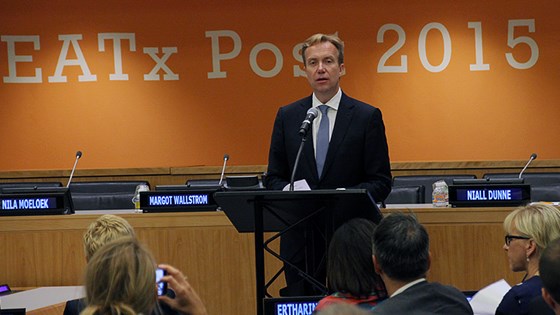Åpningsinnlegg på arrangementet EATx Post 2015
Historisk arkiv
Publisert under: Regjeringen Solberg
Utgiver: Utenriksdepartementet
New York, fredag 25. september 2015
Tale/innlegg | Dato: 25.09.2015
Utenriksminister Børge Brende holdt åpningsinnlegg på EAT X sitt post2015-arrangement under FNs generalforsamling i New York 25. september 2015.
Check against delivery.

As I speak, more than 800 million people are suffering from hunger.
Three million children die needlessly from undernutrition, every year.
And in just 35 years' time, in 2050, the world's population is expected to reach nine billion – that means another two billion people to be fed.
This represents a four-pronged challenge:
- Food supplies must be sufficient.
- Food must be nutritious and healthy.
- Food must be accessible to all.
- And food production must be sustainable.
All this is possible.
The technology is available.
Arable land is plentiful.
We know how to increase productivity and reduce the amount of water used.
But it will be demanding – and it will require the world to join hands in a global effort to fight hunger and malnutrition.
(Recognising the problem)
First we must recognise that people are starving for multiple reasons -- including poverty, discrimination, conflicts, natural disasters, climate change and food wastage.
Hunger is both a symptom of and a reason for poverty.
This means that we must address the drivers of poverty.
Households, villages and countries need to become resilient to shocks and stresses.
Increased food production is important, but not enough to eradicate hunger.
The food produced must also be nutritious, and it must be accessible to all.
The solution is not to be found in our agricultural policies alone.
The daunting task of ending hunger challenges us to take a coherent approach to poverty, nutrition, education, employment, health and the environment.
(five actions)
Allow me to present five ideas for action that could have substantial impact.
First: Investment in food production must generate local jobs.
In Sub-Saharan Africa and South Asia 70 % of young people live in rural communities.
Half of them work in agriculture.
With smarter investments, these young women and men will be able to provide healthy food for their families at the same time as they contribute to increased food production, economic growth and social stability.
Second: Well-functioning markets for both small and large food producers are crucial.
A successful outcome of the trade negotiations in the WTO will be a major contribution to food security.
Equally important is ensuring that growth is inclusive and reaches those most in need.
Third: I strongly believe in gender equality and investing in girls' education.
Women, along with other marginalised groups, have less access to land and resources.
They are faced with formal and informal obstacles.
According to the World Bank, eliminating discrimination against women will increase global agricultural output substantially.
Fourth: We need to invest more in climate smart agriculture.
Commercial agriculture is a key driver of global deforestation.
We cannot continue to eat the world's forests.
There is a need for new, innovative 'food production, forest protection' compacts between governments, the private sector and local communities.
I am excited about recent developments in this field, where we are deeply engaged through the Norwegian Climate and Forest Initiative.
Fifth: We must produce, distribute and consume food smarter.
In rich countries, one third of all food is thrown away.
In poor countries, food is often spoilt due to poor infrastructure.
The world simply cannot afford this level of waste.
(Conclusion)
Hunger is probably the greatest challenge of our time that we can solve.
This is not just a moral question.
Ending hunger is a key to ensuring a more secure, stable and sustainable world.
It is in everybody's interests.
To make it happen, we need all partners at the table - governments, farmers, scientists, civil society and the food industry.
Thank you